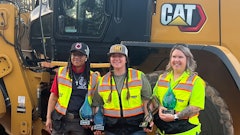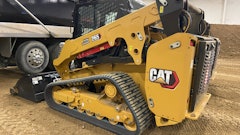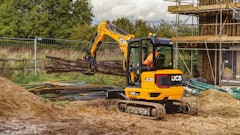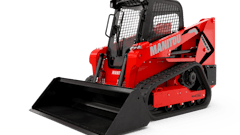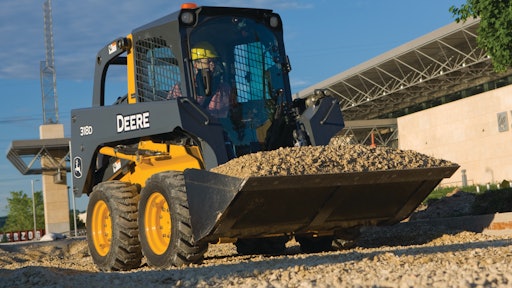
Today's skid steers are not "your father's Oldsmobile," so to speak. They’re bigger, more productive and they come with a heck of a lot more features than the machines of yesteryear. With so much to offer, how do you determine what options to choose when spec’ing a machine for your fleet?
Fortunately, models on the market today come with a lot of pretty cool stuff already built in, but if your fleet has to meet particular demands, take a look at what’s available within some of the primary selection criteria.
It’s about performance
With any piece of equipment on your jobsite, performance is the name of the game. That’s why it’s important to consider some of the features today’s skid steers have to offer to get the job done.
Curtis Goettel at Case says one of the options that can really boost performance is a two-speed transmission. “It’s a big advantage when time is money,” he says.
Other important features that optimize performance include automatic bucket self-leveling for material retention and hydraulic quick coupler to allow changing attachments from the seat. Enabling operators to stay in their climate-controlled cabs and quickly switch work tools improves versatility and functionality. “This is becoming very popular, especially on larger machines,” says Goettel. “On a machine that costs between $50,000 and $70,000, it makes a lot of sense.”
Regarding performance, Gregg Zupancic notes that John Deere also offers an exclusive hydraulically driven variable-speed cooling fan that reverses periodically to help keep the engine and hydraulic coolers clear of clogging debris.
“We also offer a unique performance package that provides creeper mode settings that allow the operator to adjust machine wheel speed independent of the engine RPMs,” Zupancic says. “This gives the operator more precise attachment control at low speeds. For example, when operating a trencher in the ground, the operator can adjust travel speed to inches per hour and match the trencher production precisely to machine travel speed. Also as part of the EH performance package, the customer can adjust boom and bucket speed limits. So if the user is a new operator or working in a tight space, the loader boom and bucket speeds can be set to match the application.”
Leading manufacturers are also offering proportional hydraulics to allow operators to infinitely adjust the flow of hydraulic oil, Goettel says. With it, operators can infinitely vary attachment speed.
Bobcat offers an optional deluxe instrumentation panel, says Greg Rostberg. “Available only on M-Series machines, the panel intelligently monitors key loader functions, and the keyless start helps prevent theft,” he says. “The new 5-inch, full-color LCD screen offers better readability and interaction. Easy-to-read virtual sweep gauges allow the operator to quickly read and understand the machine’s performance.”
Kelly Moore at Gehl points out that for optimum engine performance and longevity, owners can choose an air pre-cleaner system that can be installed as a field kit. “Particularly in dry, dusty conditions, this can really protect the life of the engine.”
Comfort is key
Ergonomics and comfort features have been catching on as equipment owners and operators realize that comfort improves productivity. Air-ride seats are particularly adept at keeping operators comfortable and happy in a skid steer, as they absorb a lot of bumps and allow the operator to raise and lower himself on a cushion of air for better overall visibility, says Deere's Zupancic.
Simple things like heat and air conditioning are also optional. A cab enclosure with heat can cost around $2,500 or so, says Moore at Gehl, but it's money well spent in harsh winter climates.
“In hot climates, pretty much anywhere past Virginia, you see fewer machines sold with cabs. But those sold with cabs have air conditioning,” says Goettel, noting that with Case, if you choose the cab option, you get it all – heat and/or AC, keyless start, removable windows and radio/MP3 player.
“Operator comfort is a big deal,” Goettel says. “Bigger cabs, creature comforts, touch controls… visibility is huge. The more comfortable an operator is, the more productive he is.”
Controls – a sensitive subject
Controls are very important to all skid steer operators. Fortunately, manufacturers realize this and have covered all the bases. "John Deere offers the end user options to provide the control pattern he is most familiar with, and thus, a more productive and comfortable operating environment," Zupancic says. "Choose from a mechanical foot control system, or choose the option to have hands-only mechanical controls configured in the H-pattern. Additionally John Deere offers EH Joystick controls that operate in the ISO control pattern. You can also opt for an EH performance package that will allow the customer to switch the controls from standard ISO configuration into an H pattern configuration."
Bobcat skid steers are available with standard hand/foot controls, which the company invented nearly 50 years ago, as well as the optional Advanced Control System (ACS) which allows switching between standard and H-pattern controls with the flip of a switch. Finally, with optional Selectable Joystick Controls, the operator uses only his hands to control all machine functions.
Electro-hydraulic (EH) switchable controls are available on all Case Alpha Series models as well. "This is especially helpful when you have two or more people running the equipment. Operators can easily switch between control patterns based on preference," Goettel said.
Cabs – size does matter
For today’s North American operator, the environment inside the skid steer is very important, and a spacious cab makes a big difference. To that end, leading manufacturers have been working to get more operating room out of an inherently tight space.
Case’s new Alpha Series skid steers feature 25 percent more room in the cab, plus increased visibility, comfort and control over previous models. Goettel says the cab is sealed and pressurized to reduce noise and dust and is designed with an ultra-narrow wire side screen with more glass surface area to provide 360-degree visibility.
To create a better working environment, Bobcat increased the size of the M-Series cab by 10 percent, improved cab pressurization and redesigned the interior to allow operators to adjust the environment to their individual preferences. "Bobcat M-Series loaders have a best-in-class pressurized cab, with a new one-piece seal that goes all the way around the door and fits into a special curved pocket," Rostberg says. "This minimizes the amount of dirt and dust that might enter the cab, creating more enjoyable working conditions and making it easier to clean the cab.
"Noise is another factor affecting operator comfort, and Bobcat reduced the sound level of M-Series loaders by more than 60 percent," Rostberg adds. "New engine mounts improve isolation to decrease vibration and reduce sound levels. Control levers on the optional Selectable Joystick Controls (SJC) move up and down in conjunction with the seat to reduce arm movement and fatigue as the operator controls the machine. Joystick mounts slide forward or backward to adjust to the preference of each individual operator."
Rostberg adds, "The more comfortable an operator is and the better he can see the task at hand, the more efficient they will be on the jobsite."
What’s next?
With or without the extra bells and whistles, skid steers are constantly evolving to provide operators with more performance and comfort, and you can expect that trend to continue.
"We expect machines to get easier to operate and help customers get their job done more accurately and faster," says Zupancic at Deere. "In the future, we expect to see manufacturers taking advantage of the drive-by-wire technology of EH joystick controls by integrating more push-button automatic features. These could include technologies that allow the machine to recognize previous operator settings, help the operator control the machine more precisely around the jobsite, or automatically move the machine into the right position to complete a task. In the future only the sky is the limit for new features and options that help improve a customer’s productivity, uptime and at a lower daily operating cost."

















